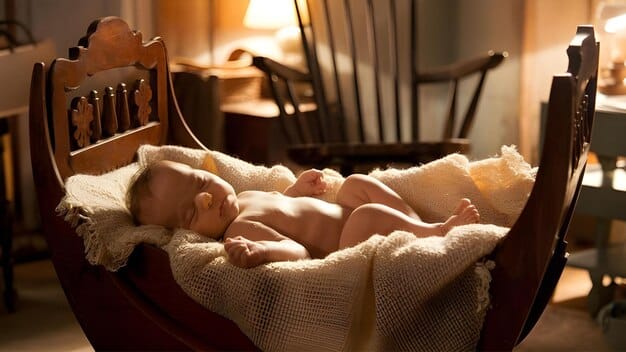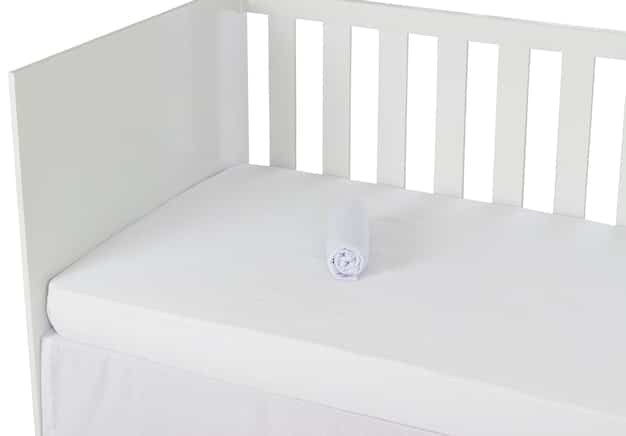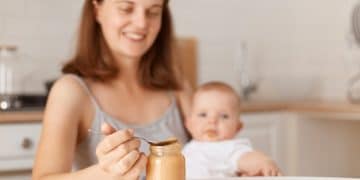Safe Sleep for Infants: New US Guidelines in 2025

Recent Updates: New Guidelines on Safe Sleep Practices for Infants in US (2025) emphasize creating a safe sleep environment by placing infants on their backs on a firm surface, avoiding soft bedding and crib bumpers, and ensuring the absence of secondhand smoke exposure to reduce the risk of Sudden Infant Death Syndrome (SIDS).
Ensuring the safety of infants during sleep is a top priority for parents and caregivers, and the Recent Updates: New Guidelines on Safe Sleep Practices for Infants in US (2025) provide crucial information to minimize risks and promote healthy sleep habits from day one.
Understanding the Importance of Safe Sleep Practices
Safe sleep practices are essential for reducing the risk of Sudden Infant Death Syndrome (SIDS) and other sleep-related infant deaths. These practices are based on extensive research and are continually updated to reflect the latest evidence. Understanding and implementing these guidelines can significantly improve infant safety.
What is Sudden Infant Death Syndrome (SIDS)?
SIDS is the unexplained death of a seemingly healthy baby, usually during sleep. While the exact cause of SIDS remains unknown, research has identified several risk factors that parents can mitigate through safe sleep practices.
Why are Safe Sleep Guidelines Important?
Following safe sleep guidelines can reduce the risk of SIDS and other sleep-related infant deaths. These guidelines are designed to address known risk factors and create a safer sleep environment for infants.
- Reduces SIDS Risk: Adhering to guidelines significantly lowers the risk of SIDS.
- Promotes Better Sleep: Safe sleep environments contribute to better infant sleep quality.
- Educates Caregivers: Guidelines provide essential knowledge for parents and caregivers.
By understanding the importance of safe sleep practices, parents and caregivers can take proactive steps to protect infants during their most vulnerable hours.
Key Updates in the 2025 Safe Sleep Guidelines
The Recent Updates: New Guidelines on Safe Sleep Practices for Infants in US (2025) incorporate the latest research and expert recommendations. These updates aim to provide clearer, more actionable advice for parents and caregivers, focusing on creating a safe sleep environment from birth.
Back to Sleep: The Foundation of Safe Sleep
Placing infants on their backs to sleep remains a cornerstone of safe sleep practices. This position has been shown to significantly reduce the risk of SIDS.
Firm Sleep Surface: What You Need to Know
A firm sleep surface is crucial. Soft surfaces, such as sofas, recliners, or soft mattresses, increase the risk of suffocation and SIDS.
- Use a Firm Mattress: Ensure the crib mattress is firm and fits snugly.
- Avoid Soft Bedding: Keep soft bedding, such as pillows and blankets, out of the crib.
- No Inclined Sleepers: Avoid using inclined sleepers, as they pose a suffocation risk.

These updates emphasize the importance of creating a consistent and safe sleep environment for every nap and bedtime.
Creating a Safe Sleep Environment: Practical Steps
Creating a safe sleep environment involves several practical steps that parents and caregivers can take to minimize risks and promote healthy sleep. These steps include choosing the right crib, positioning the infant correctly, and maintaining a safe room temperature.
Choosing the Right Crib
The crib should meet current safety standards and have a firm, flat mattress that fits snugly. Regularly inspect the crib for any loose parts or damage.
Optimal Room Sharing Without Bed Sharing
While bed sharing is discouraged, room sharing is recommended. Having the infant sleep in the same room as the parents (but in a separate crib) can reduce the risk of SIDS.
Maintaining a Safe Room Temperature
Keep the room at a comfortable temperature to prevent overheating, which is a risk factor for SIDS.
By following these practical steps, parents can create a safe and comfortable sleep environment that promotes infant health and well-being.
Debunking Common Myths About Infant Sleep
Many myths and misconceptions surround infant sleep, which can lead to unsafe practices. Understanding the facts and debunking these myths is crucial for ensuring infant safety. Often times, parents are confused because of various sources of information.
Myth: Infants Sleep Better on Their Stomachs
This is a dangerous myth. Placing infants on their stomachs significantly increases the risk of SIDS.
Myth: Crib Bumpers Prevent Injuries
Crib bumpers pose a suffocation risk and are not recommended. They offer no proven benefit and can be dangerous.
Myth: Bed Sharing is Always Safe
Bed sharing increases the risk of SIDS, especially if the parents smoke, are under the influence of alcohol or drugs, or are excessively tired.
- Sleeping on Stomach: Always place infants on their backs.
- Using Crib Bumpers: Avoid crib bumpers due to suffocation risk.
- Bed Sharing: Increases SIDS risk, especially in certain conditions.
By dispelling these common myths, parents can make informed decisions based on evidence-based guidelines.
The Role of Healthcare Providers in Promoting Safe Sleep
Healthcare providers play a vital role in educating parents and caregivers about safe sleep practices. They can provide personalized advice, address concerns, and reinforce the importance of following guidelines. Also, physicians play a lead role as well.
Educating Parents and Caregivers
Healthcare providers should discuss safe sleep practices during prenatal visits and well-baby checkups.
Addressing Parental Concerns
Parents may have questions or concerns about safe sleep practices. Healthcare providers should address these concerns empathetically and provide evidence-based guidance.

Reinforcing Guidelines
Regularly reinforcing safe sleep guidelines can help ensure that parents and caregivers remain vigilant and consistent in their practices.
The engagement of healthcare providers is essential for spreading awareness and promoting the adoption of safe sleep practices within communities.
Resources for Parents: Staying Informed and Supported
Numerous resources are available to help parents stay informed about safe sleep practices and access support when needed. These resources include websites, support groups, and educational materials. Also, it’s important to stay updated!
Websites and Online Resources
Websites such as the American Academy of Pediatrics (AAP) and the National Institute of Child Health and Human Development (NICHD) offer comprehensive information about safe sleep.
Support Groups and Community Programs
Local support groups and community programs can provide valuable peer support and education.
Educational Materials
Brochures, videos, and other educational materials are available to reinforce safe sleep messages.
Staying informed and accessing support can empower parents to make the best decisions for their infants’ safety and well-being.
| Key Point | Brief Description |
|---|---|
| 🚼 Back to Sleep | Always place infants on their backs to reduce SIDS risk. |
| 💪 Firm Surface | Use a firm mattress and avoid soft bedding. |
| 🚭 Smoke-Free | Avoid secondhand smoke exposure for infants. |
| 🌡️ Room Sharing | Share a room, but not a bed, with the infant. |
Frequently Asked Questions
▼
The safest sleep position for your baby is on their back. This position significantly reduces the risk of Sudden Infant Death Syndrome (SIDS). Always place your baby on their back for every sleep.
▼
No, crib bumpers are not safe for your baby. They pose a suffocation and entanglement risk. It’s best to keep the crib free of any soft objects, including bumpers, pillows, and blankets.
▼
Use a firm mattress that fits snugly in the crib. A firm surface is essential to reduce the risk of suffocation. Avoid soft mattresses or placing anything under the mattress to elevate it.
▼
Bed sharing is not recommended, especially if you smoke, are under the influence of alcohol or drugs, or are excessively tired. Room sharing is a safer alternative, where the baby sleeps in a separate crib in the same room as you.
▼
Dress your baby in a sleep sack or wearable blanket to keep them warm without the risk of loose blankets in the crib. Ensure the sleep sack fits properly and is the right size for your baby.
Conclusion
The Recent Updates: New Guidelines on Safe Sleep Practices for Infants in US (2025) are designed to provide parents and caregivers with the best possible information to ensure infant safety during sleep. By following these guidelines, debunking common myths, and staying informed, you can create a safe and nurturing sleep environment for your baby, reducing the risk of SIDS and promoting overall well-being.





